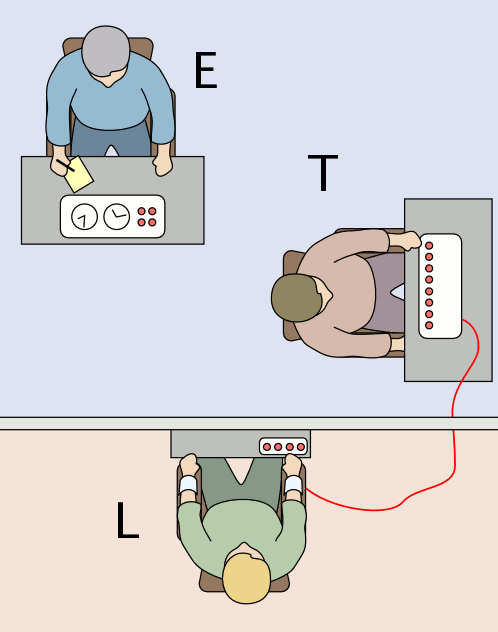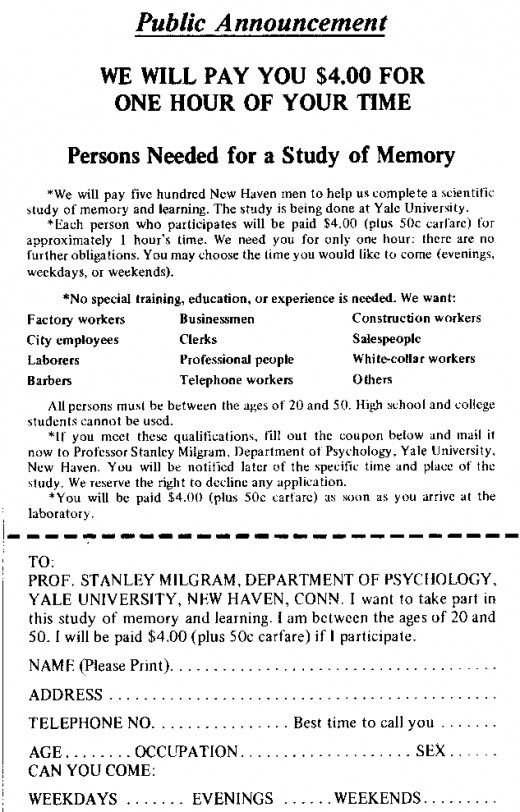Milgram Experiment

What is the Milgram Experiment?
The Milgram Experiment was meant to study a person's willingness to obey authority figures. The Milgram Experiment was conducted by Stanley Milgram in July of 1961.
The experiment seemed like it was an experiment to test memory and the ability to learn. The experiment involved a 'volunteer' who was to learn what the teacher, another volunteer, was teaching. There was another person, the authority figure, who was observing the experiment. This person was the person running the experiment.
What the teacher didn't know was that the learner was a pretend volunteer and the experiment really wasn't about testing memory.
40 volunteers were chosen to participate in this experiment for $4.50.
Prods the 'Authority Figure' Used
- Please continue.
- The experiment requires you to continue.
- It is absolutely essential that you continue.
- You have no other choice but to continue.
Transcript of Audio Recording (Learner)
- 75v - Ugh!
- 90v - Ugh!
- 105v - <Louder> Ugh!
- 120v - Ugh! This really hurts!
- 135v - Ugh!
- 150v - Ugh! Experimenter! That's all. Get me out of here. I told you I had heart trouble. My heart's starting to bother me now. Get me out of here, please. My heart's starting to bother me. I refuse to go on. Let me out.
- 165v - <Shouting> Ugh! Let me out!
- 180v - <Shouting> Ugh! I can't stand the pain. Let me out of here.
- 195v - Ugh! Let me out of here. Let me out of here. My heart's bothering me. Let me out of here! You have no right to keep me here! Let me out! Let me out of here! Let me out! Let me out of here! My heart's bothering me. Let me out! Let me out!
- 210v - Ugh! Experimenter! Get me out of here. I've had enough. I won't be in the experiment anymore.
- 225v - Ugh!
- 240v - Ugh!
- 255v - Ugh! Get me out of here.
- 270v - <Screaming> Let me out of here. Let me out of here. Let me out of here. Let me out. Do you hear? Let me out of here.
- 285v - <Screaming>
- 300v - <Screaming> I absolutely refuse to answer any more. Get me out of here. You can't hold me here. Get me out. Get me out of here.
- 315v - <Intense screaming> I told you I refuse to answer. I'm no longer part of this experiment.
- 330v - <Intense and prolonged screaming> Let me out of here. Let me out of here. My heart's bothering me. Let me out, I tell you. <More hysterical> Let me out of here. Let me out of here. You have no right to hold me here. Let me out! Let me out! Let me out! Let me out of here! Let me out. Let me out.
- 345v-450v - <Silence>
What Happened During the Milgram Experiment?
Before the experiment started, the teacher and the learner met. The learner was hooked up to a machine that emitted electric shocks that would shock the learner if he got the answer wrong. The teacher was also told that the learner had a heart problem. After the teacher and learner met, the teacher was brought to another room that had a machine that controlled the electric shocks to the learner.
To instill the fact that the learner would be shocked if he got an answer wrong, the teacher was given a quick shock similar to what the learner would get. For every wrong answer, the teacher would increase the shocks strength by 15-volts all the way up to 450-volts. The machine was labeled at different increments with slight shock at 15-volts, to severe shock at 375-volts, all the way to XXX at 450-volts.
The teacher, after teaching the learner word groups, would ask the learner questions regarding the word groups. The learner, would purposefully get the answers wrong so the teacher would have to shock him. Little did the teacher know, but the learner was not hooked up to the machine anymore and he was not receiving any shocks at all.
After a bit, the learner would start protesting and beg the teacher to stop. When the voltage got up to 135-volts and the teacher would start to protest, the "authority" would tell the teacher to continue using verbal cues. If the teacher still persisted to stop after four verbal cues, the experiment would end. If not, the experiment would end after the teacher got to and successfully emitted 450-volts to the learner.
Results of the Milgram Experiment
Milgram conducted many surveys before the start of the experiment and all of the surveys said they predicted that the teachers wouldn't make it far before they stopped.
- A survey of psychology majors predicted that only 1.2 teachers (out of 100) would inflict 450-volts.
- A survey of Milgram's colleagues suggested a small amount of teachers would inflict 450-volts.
- A survey of psychiatrists from a medical school suggested that when the victim demands to be free, most teachers would stop the experiment. When the learner refused to answer, they predicted only 3.73% of teachers would continue with the experiment, and only about 1% of teachers would make it to the last shock.
The results though, proved different. 65% of the teachers administered the final shock in the first set of experiments even though all of the teachers questioned the experiment at some point. Out of all the participants, 26 participants dealt the maximum shock at 450-volts while only 16 participants stopped the experiment before the final shock was given. All participants made it at least to 300-volts.
Many of the teachers experienced signs of stress and anxiety during the experiment.
Do you think Milgram Experiment is ethical?
Ethical Issues of the Milgram Experiment
Although the Milgram Experiment sparked much controversy due to the high stress and anxiety the experiment caused, the majority of the volunteers expressed thanks to Milgram for the experiment.
Not so much ethical issues, but participants of the experiment assumed the authority figure was an expert in what they were doing and were compliant with what the authority figure said, even though the authority didn't have to prove much to show he was the 'authority'.








